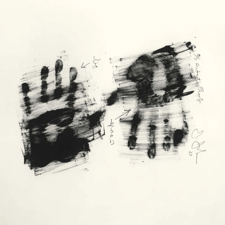A Field Guide to Criminology
How did a discipline fascinated by deviance wind up with so many taboos?
By Colleen P. Eren
“Hand” by Jasper Johns. The Art Institute of Chicago, licensed under CC0.
Criminology programs can never repay their debt to Criminal Minds, Law and Order SVU, The First 48, and CSI: Crime Scene Investigations—dramas incoming freshmen routinely cite as motivators for pursuing criminology degrees. Besotted with these shows, entering students assure us they want to “understand the criminal mind.” They want to become forensic psychiatrists or behavioral experts or special agents for the FBI, to run blood spatter and bullet trajectory analyses. They want to become forensic scientists, to litigate exciting cases, and, in some cases, provide justice as police officers.
Given popular depictions of criminology—the study of the making, breaking, and enforcing of laws—undergraduate misperceptions are understandable. And, to be fair, it’s not as if the field is a monolith. The discipline regularly engages in boundary policing (pun intended) even though it is internally fragmented, rife with disagreement about which methodological and theoretical frameworks should drive research, thick with taboos about topics that can be investigated.
Prior to becoming a discrete academic discipline in the twentieth century, the study of criminality was something scholars from law, psychology, biology, sociology, and medicine took on as a specialized area of interest. Histories of criminology almost uniformly trace the origin of the field to Italian Enlightenment-era jurist Cesare Beccaria (1738-1794), a founder of the Classical School of criminology which held that, properly applied, punishment would act as a deterrent. The 19th and early 20th centuries saw the bloom of the Positivist School, also led also by Italians—the physician Cesare Lombroso and his students, including lawyers Enrico Ferri and Raffaele Garofalo. The positivists believed in the power of science to quantify, explain, and prevent crime.
Sociologists from the 1930s onward—including notably Edwin Sutherland, who coined the term “white collar crime”—marshalled the study of crime into a specialty within their own discipline. This led to the overrepresentation of sociologists in the field we still see to this day. In fact, criminology programs are still frequently housed—often uneasily—within sociology departments, with implications for curricula and research.
To say sociology and criminology have been going through a 50-year-long divorce might be too dramatic; sociology’s influence is still sizable. But criminology has long been pushing to come out from under sociology’s sometimes patronizing wing. Criminology’s first standalone doctoral-granting program was launched when Florida State University admitted its first student in 1958, but more than half of today’s doctoral programs admitted their first students only after 1990. Although many criminologists once submitted their peer-reviewed work to sociology journals, this has changed with the rise of prestigious criminology journals. And while there has been a leftward pull in the field of criminology—mirroring academia in general—sociology has trended even harder left.
Criminology’s burgeoning separation from sociology doesn’t mean criminologists feel perfectly at home in the seemingly synonymous discipline of criminal justice, a field that traces its own roots to an American police chief, August Vollmer. (Incidentally, Vollmer twice jumped onto runaway trains to prevent catastrophic crashes, an origin story seemingly unmatched by any other academic discipline.) Vollmer attempted in the early 20th century to professionalize police work and make effective law enforcement a subject of scholarly inquiry, founding the first criminal justice education programs at U.C. Berkeley in 1916. Still, it took until 1968 for SUNY Albany to offer the first free-standing Ph.D. in criminal justice.
Although people with criminal justice doctorates investigate a range of topics, they have concentrated on the administration of the institutional pillars of the criminal justice system. Because criminal justice is more applied, linked to criminal justice vocations, and sometimes taught by former law enforcement members-turned-faculty, sociologists and criminologists often look down on it, particularly deriding low status, educational-mill “cop shops” where war stories and “copaganda” allegedly flourish and little important (read, progressive) scholarship is produced.
What about methodology? Interest in the possible biological origins of crime date back to physician Cesare Lombroso and his tome, The Criminal Man (1876). In that book, heavily influenced by Darwin, Lombroso theorized “[in]born criminality,” discussing the physical abnormalities he observed among criminals, compiling quite the collection of skulls in his phrenological pursuits. (By his own request, his head is now jarred and on display at Turin’s Museum of Psychiatry and Criminology.) In 1893, he extended his interests in criminal pathologies to the fairer sex, publishing Criminal Woman, The Prostitute, and the Natural Woman.
Lombroso’s flawed methodologies, pseudoscience, and indirect connection to mass slaughter, fascism, and eugenics delegitimized and made taboo biosocial criminology for most of the 20th century.
Though Jewish, socialist, and by his own estimation progressive, Lombroso's work was intertwined with contemporary scientific racism and the eugenics movement, giving a scholarly veneer and acceptability to the idea of eliminating populations “born” dangerous. Lombroso ultimately declared criminals to be evolutionary throwbacks who resembled “savages” and “primitive races” with animal-like qualities. His students collaborated with the Italian fascist regime and Lombroso was temporarily revered by that regime, at least until his Jewishness became a problem for them and they unceremoniously took down his monument in Verona and removed his name from street signs.
Lombroso’s flawed methodologies, pseudoscience, and indirect connection to mass slaughter, fascism, and eugenics delegitimized and made taboo biosocial criminology for most of the 20th century. This despite the fact that some of Lombroso’s students’ presented quite reasonable, nuanced approaches. For example, Lombroso disciple Enrico Ferri took the position that “[w]e must study all the possible data that can be causes of crime—the man’s heredity, the man’s physical and moral make-up, his emotional temperament, the surroundings of his youth, his present home, and other conditions.”
Over the past few decades, the taboo around biological theorizing has eased, with more incorporation of biocriminology into mainstream criminology textbooks and a rise of researchers like Adrian Raine interested in the neurobiological and biosocial causes of antisocial behavior and violence. However, among the more sociologically-oriented and left-leaning, biological explanations of deviant behaviors are still often discredited, reflexively linked with racism, fascism, and sexism.
Those who wish to publish ethnographies of subcultures involved in criminal behavior are sometimes involved in controversies around ethics, as they are accused of engaging in criminal activity themselves, a lack of objectivity, and even romanticizing criminal behavior.
Indeed, criminology’s do’s and don’ts generally bifurcate predictably according to sociology’s ideological progressivism. Publishing on the disproportionate incarceration rates among Black and Brown people? Acceptable. Publishing on differential rates of offense by race or ethnicity? Not acceptable. Publishing on misogyny’s role in men’s domestic violence against women? Fair game. Publishing about the relative likelihood women won’t be arrested for assaulting men? Controversial. Publishing on rape’s linkage to patriarchy and power? All good. Publishing about rape being driven by a desire for sex? You can guess how that goes.
The progressive shift towards minimizing sex differences and prioritizing gender identity has led to additional taboos. Heterodox Academy member and criminologist Callie Burt experienced this firsthand after she published “Scrutinizing the U.S. Equality Act 2019” in Feminist Criminology in 2020. The work criticized the Act’s conflation of sex and gender and its prioritization of self-identification for access to sex-segregated spaces like prisons and domestic violence shelters. Labeled a transphobe on a professional organization’s listserve, she was removed from Feminist Criminology’s editorial board, with the record of the board’s vote citing her potential to “[send] the wrong message about the inclusive intent of the journal.”
Disciplinary methods are also contested in criminology. Qualitative research is seen as less rigorous, except by more left-leaning scholars (who view quantitative, positivist scholarship skeptically, as a form of an oppressive, Western, empiricist gaze), and is published infrequently in top criminology journals. Those who wish to publish ethnographies of subcultures involved in criminal behavior are sometimes involved in controversies around ethics, as they are accused of engaging in criminal activity themselves, a lack of objectivity, and even romanticizing criminal behavior.
For all of the disciplinary policing within criminology, it turns out to be a remarkably anarchical discipline, lacking unity over even basic theoretical precepts. But one might well be introduced to its study through controversies played out among its schools of thought. Whether this makes it a true discipline or a mere reflection of political orientation or even an art is a fair question. Maybe that’s fitting for a field whose chief subject is deviance.
